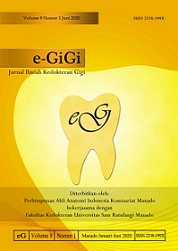Pengaruh Perendaman Ekstrak Bunga Sepatu (Hibiscus rosa sinensis L.) terhadap Pertumbuhan Candida albicans pada Plat Resin Akrilik
Abstract
Abstract: Denture plate materials such as acrylic resin can induce adhesion of Candida albicans. Therefore, acrylic resin needs to be immersed in disinfectant. However, disinfectant can change its physical and mechanical properties, hence an alternative material is needed, such as hibiscus flower (Hibiscus rosa sinensis L.) due to its antifungal activity. This study was aimed to identify the effects of hibiscus flower extract and its concentrations towards the growth of C. albicans on acrylic resin plates. This was an experimental and laboratory study using the post-test only with control group design. Acrylic resins were immersed in suspension of C. albicans, then were divided into four groups, as follows: 62.5% and 75% hibiscus flower extract (group I and II), positive control (sodium hypochlorite), and negative control (sterile aquadest). Acrylic resins were cultured and incubated on SDA media for 24 hours then the number of colonies were calculated. The results showed that C. albicans colonies in the treatment groups I, II, negative control, and positive control were 495 CFU/ml, 571.25 CFU/mL, 1175 CFU/mL, 23.125 CFU/mL respective-ly. The Kruskal-Wallis test showed significant differences in number of colonies of C. albicans (p<0.05) among all groups The post hoc Mann-Whitney test showed that all groups were significantly different, except for treatment groups I towards II. In conclusion, extract of hibiscus flower (H. rosa sinensis L.) affected the growth of C. albicans on acrylic resin plates.
Keywords: hibiscus flower; Hibiscus rosa sinensis L.; Candida albicans; acrylic resin
Abstrak: Adanya bahan plat basis gigi tiruan seperti resin akrilik dapat memicu perlekatan C. albicans; oleh karena itu, resin akrilik perlu direndam dalam larutan desinfektan. Namun, larutan desinfektan dapat mengubah sifat fisik dan mekanik dari akrilik sehingga diperlukan adanya bahan alternatif, antara lain bunga sepatu (Hibiscus rosa sinensis L.) yang memiliki aktivitas antifungal. Penelitian ini bertujuan untuk mengetahui pengaruh perendaman ekstrak dan konsentrasi bunga sepatu terhadap pertumbuhan C. albicans pada plat resin akrilik. Jenis penelitian ialah eksperimental laboratorik dengan post-test only with control group design. Resin akrilik direndam dalam suspensi C. albicans, Terdapat empat kelompok perlakuan yaitu ekstrak bunga sepatu 62,5% dan 75%, kontrol positif (sodium hipoklorit), dan kontrol negatif (akuades steril). Resin akrilik dikultur dan diinkubasi pada media SDA selama 24 jam, kemudian jumlah koloni C. albicans dihitung. Hasil penelitian ini menunjukkan jumlah koloni C. albicans kelompok perlakuan I, II, kontrol negatif, dan positif sebanyak 495 CFU/ml, 571.25 CFU/mL, 1175 CFU/mL, 23.125 CFU/mL secara berurut. Uji Kruskal-Wallis menunjukkan perbedaan jumlah koloni C. albicans yang bermakna (p<0.05) antar semua kelompok. Uji post hoc Mann-Whitney menunjukkan semua kelompok berbeda bermakna, kecuali kelompok perlakuan I dengan II. Simpulan penelitian ini ialah ekstrak bunga sepatu (H. rosa sinensis L.) berpengaruh terhadap pertumbuhan C. albicans pada plat resin akrilik.
Kata kunci: bunga sepatu; Hibiscus rosa sinensis L.; Candida albicans; resin akrilik
Full Text:
PDFDOI: https://doi.org/10.35790/eg.9.2.2021.34104
Refbacks
- There are currently no refbacks.

